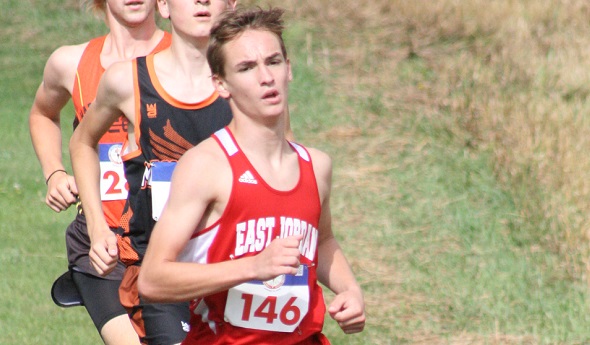
Seniors Setting Pace for East Jordan Run
August 23, 2019
By Chris Dobrowolski
Special for Second Half
EAST JORDAN — Matt Peterson says he couldn’t have asked for a better group than the one he has this year making up his boys cross country team at East Jordan.
 Peterson also couldn’t have asked for more experience than the Red Devils bring into the 2019 season.
Peterson also couldn’t have asked for more experience than the Red Devils bring into the 2019 season.
East Jordan returns its top five runners from a team that finished third at the Lower Peninsula Division 4 Finals last year, all part of a senior class that has made a major impact for the Red Devils over the past three years.
“Not only are they hard workers and pretty talented runners,” said Peterson, “they’re all just real high-quality kids. They truly lift up everyone around them, not just on our team but in the school. They’re just positive, positive kids, every one of them. I feel super lucky to have them.”
Ethan Nachazel, Aaron Nachazel, Ben Hardy, Alex Schlueter and Caleb Carson are the quintet the Red Devils have leaned on primarily since they entered high school. They led East Jordan to a pair of top-10 finishes in 2017 and 2018 after snapping a 16-year Finals drought for a program that won titles in 1998 and 2000.
The seniors are the best of friends, spending countless hours together at sleepovers or for training runs. Their relationships have forged a bond of cohesiveness between the veteran leaders of the team and the squad in general.
“We’ve all grown up together since kindergarten, and we know each other pretty well,” said Ethan Nachazel. “We keep each other accountable. It’s just nice to know you have all these guys keeping each other together. It’s very important because not only do you work better together and improve quicker, but you also bond way quicker together than you would just by being at practice.”
By all accounts Ethan Nachazel is the Red Devils’ top runner, finishing a team-best 14th overall at last year’s Final and 28th overall to pace East Jordan in 2017. But after that, the pecking order can change from meet to meet and year to year. Hardy, for example, was East Jordan’s fourth counter at the 2017 Final, but improved his time by 1 minute, 14 seconds at last season’s meet to take 15th overall, finishing alongside Ethan Nachazel.
“Ethan has been predominately our first guy, except for one or two meets last year,” said Peterson. “I expect the top five or six to probably move around a bit.”
The Red Devils’ seniors, a collection that has a team-first mindset, have no qualms about who finishes in what order. They’ve set a standard amongst themselves to work toward the ultimate goal — team success.
“It’s fun,” said Nachazel. “We all take the lead during workouts, and we all try to share as much as we can. I think we all contribute just as much. We share the wealth equally.”
“I don’t think it would matter if someone ran well and they were normally the second guy and became the fourth guy because someone knocked them out of their place, but it helped the team,” said Peterson. “They would be OK with that.”
From serious to silly, the Red Devils’ seniors have diverse personalities, but that seems to work toward their advantage in creating good team chemistry, too.
“I think that’s a good mix to have,” said Peterson. “You need to have the serious kids on the team, and you need to have the kids who will provide a little levity and help kids relax once in a while.”
East Jordan’s coach describes Ethan Nachazel as the most serious, while Schlueter brings a humorous side to the equation.
“I think it’s very important to be light-hearted outside of practice and in practice too,” said Schlueter. “Just kind of get everyone’s spirits up. If we were too focused for too long we would just run out of that mental energy at the end of the season, and we don’t want that so I just keep everything light. But when it comes to race day, when we get on that line, it’s just focus.”
The Red Devils have depth outside of their seniors as well. Peterson sees junior Phillip Nemecek and sophomore Caleb Ziebarth as having the capabilities to contribute and perhaps even crack the top five on the team.
Ultimately, the Red Devils are hoping it all leads to another trip to the Finals. There’s no doubting East Jordan is armed with the experience and the ability.
“I think the key for this team, but I could say for any cross country team, is us having a small 1-to-5 gap,” said Peterson. “If we’re fortunate enough to get to the state meet again, I think the team that can pack it up the most and have the smallest gap is going to have the potential to be really successful.”
No matter what happens, though, the Red Devils know the friendships and connections they’ve formed over the years are, and will remain, strong.
“Cross country is one of the best things I’ve ever done,” said Schlueter. “I’ve just met so many people that I love. I’ve fallen in love with these guys. I couldn’t ask for anyone better.”
 Chris Dobrowolski has covered northern Lower Peninsula sports since 1999 at the Ogemaw County Herald, Alpena News, Traverse City Record-Eagle and currently as sports editor at the Antrim Kalkaska Review since 2016. He can be reached at [email protected] with story ideas for Manistee, Wexford, Missaukee, Roscommon, Ogemaw, Iosco, Alcona, Oscoda, Crawford, Kalkaska, Grand Traverse, Benzie, Leelanau, Antrim, Otsego, Montmorency, Alpena, Presque Isle, Cheboygan, Charlevoix and Emmet counties.
Chris Dobrowolski has covered northern Lower Peninsula sports since 1999 at the Ogemaw County Herald, Alpena News, Traverse City Record-Eagle and currently as sports editor at the Antrim Kalkaska Review since 2016. He can be reached at [email protected] with story ideas for Manistee, Wexford, Missaukee, Roscommon, Ogemaw, Iosco, Alcona, Oscoda, Crawford, Kalkaska, Grand Traverse, Benzie, Leelanau, Antrim, Otsego, Montmorency, Alpena, Presque Isle, Cheboygan, Charlevoix and Emmet counties.
PHOTO: East Jordan’s Ethan Nachazel leads a pack during Saturday’s Ryan Shay Memorial Invitational. (Photo by Chris Dobrowolski.)

MHSAA Vault: MIS Rose to Challenges to Host 2020 LP Finals
By
Rob Kaminski
MHSAA benchmarks editor
November 12, 2021
The “MHSAA Vault” features stories from past publications and other documents in the MHSAA Library. This issue takes a look at the MHSAA Cross Country Finals at Michigan International Speedway, which celebrated 25 years in 2020 – although it was an event that nearly didn’t happen last fall …
In 1996, the MHSAA and Michigan International Speedway began a partnership the changed the course of the Lower Peninsula Cross Country Finals – quite literally.
The land in and around the track at Brooklyn would host the Finals for all classes of runners in one place on one day, an annual festival of nearly 2,000 runners competing for the MHSAA’s top honors.
Even skeptics – and there were several among running purists who thought the course was too flat, for example – can’t deny the results.
Finals attendance nearly doubled in that first year, and crowds in excess of 10,000 have enjoyed a day of racing several times, including a record 12,153 in 2011.
Enthusiastic crowds were the norm in recent years, with 11,232 in 2017, and nearly 11,000 in 2018 (10,989) and 2019 (10,873).
In fact, attendance failed to reach at least 8,000 only twice since the move to MIS.
Of course, last year was an exception, when attendance was limited to 1,000 spectators per session due to the COVID-19 Pandemic. Fans also were restricted to the grandstands rather than following the action throughout locations on the course.
To reduce the number of runners in each race, the event was spread over two days, with each Division being run in two separate “sections” with times then combined at the end to determine team and individual champions.
While not ideal, the end result was another year of fantastic efforts at MIS – both from student-athletes and those behind the scenes.
“Even at the last hour, less than a week ahead of the Finals, we were closer to not having the Finals than we were to having them,” said MHSAA Assistant Director Cody Inglis, who coordinates the cross country postseason. “Rumors and challenges of mandated shutdowns, testing and other requirements were being discussed and caused a lot of unknowns. Even at the Regional level, we had schools, Regional courses and hosts shutting down their facilities; we had to relocate four Regionals 48 hours prior to race times. That scenario just could not happen at the Finals level where far more runners and much more travel would be involved.”
Among the many last-minute hurdles was the edict from NASCAR – which owns MIS – that all persons on site be temperature checked upon entry. That meant securing thermometers that were easy to operate in short order, along with personnel necessary to conduct the readings.
The attendance limitations certainly helped to implement the temperature screening, but brought their own issues.
“Limiting spectators was not a popular decision, but it really was the only way to have a race,” Inglis said. “We were taking direction and working with policies and protocols from the MDHHS, the Governor’s office, Lenawee County Health Department, MIS and NASCAR.”
Part of the solution was to utilize the grandstands as a “barrier” between participants and spectators. The reduced number of fans were dispersed over thousands of seats while still allowing them the chance to watch their student-athletes compete.
“It wasn’t the same, it wasn’t easy or perfect, but it was what we had to do to have a race,” Inglis said. “Separating the Finals into two days and different sections also allowed us to spread out the event and limit the number of people on site at any one time. This was a key part of the plan and worked well even though it separated races within a Division.”
The MHSAA, MIS and the cross country community never lost focus of the main goal: a culmination of the season for the student-athletes, who deserved something last year more than ever. And, more than ever, MIS once again displayed its advantage as a venue that could adapt to the fluid nature of the times to pull off the event.
“There were some thoughts of using four different sites, but as we learned during the Regionals, the climate of things was so tenuous from one area of the state to another that we couldn’t be 100-percent certain that there wouldn’t again be last-minute cancelations,” Inglis said. “MIS was wonderful to work and collaborate with, and was the best option to get it done. It was never mentioned once publicly about the possibility of not having the Finals – only how we could best do it under uncharted conditions.”
The moving parts and ever-changing scenarios created more complexity than ever in finalizing a season, but every decision was made with the complete desire to conduct the Finals as close to normal as possible.
“I firmly believe that a finish to the season, no matter the differences in race formatting and fan experience, was something everyone would have taken when the season began in August,” Inglis said.
Indeed, the finish line in Year 25 at MIS might have been the most gratifying of them all.

